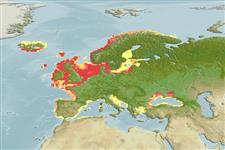Environment: milieu / climate zone / depth range / distribution range
Ecologie
marien; brak water demersaal; diepte 1 - 96 m (Ref. 57178). Temperate; 72°N - 36°N, 23°W - 42°E
Northeast Atlantic: Murmansk to Spain, including Iceland and the Baltic (Ref. 4674). Reports from the Mediterraneanare misidentications (Ref. 125963). Two distinct but often sympatric spawning groups exist in the area but have not been given subspecies status although spawning groups differ in mean vertebral number (autumn higher than spring), otolith structure, and probably habitats.
Lengte bij maturiteit / Grootte / Gewicht / Leeftijd
Maturity: Lm 13.0, range 11 - 15 cm
Max length : 20.0 cm SL mannelijk / geslacht onbekend; (Ref. 3397); max. gerapporteerde leeftijd: 7 Jaren (Ref. 729)
Dorsale stekels (totaal) : 0; Dorsale zachte stralen (totaal) : 49 - 58; Anale zachte stralen: 24 - 32; Wervels: 60 - 68. Scales present in the midline anterior to dorsal fin and over the musculature at base of caudal fin. Belly scales in tight chevron. Margins of dorsal and anal fins straight with rays of equal length. Lateral line pores linearly arranged along the un branched canals. Back typically sandy brown.
Territorial; found in inshore waters, especially sandy bays and beaches, including the inter-tidal zone and estuaries; rarely offshore. Alternate between lying buried in the sandy substrate and swimming in schools in the water mass. Adults feed on zooplankton and some large diatoms (Ref. 3397). They hibernate in winter buried in sand at depths of 20-50 cm (Ref. 35388).
Bauchot, M.-L., 1987. Poissons osseux. p. 891-1421. In W. Fischer, M.L. Bauchot and M. Schneider (eds.) Fiches FAO d'identification pour les besoins de la pêche. (rev. 1). Méditerranée et mer Noire. Zone de pêche 37. Vol. II. Commission des Communautés Européennes and FAO, Rome. (Ref. 3397)
Status op de Rode Lijst van het IUCN (Ref. 130435)
Gevaar voor de mens
Harmless
Gebruik door de mens
Visserij: van groot commercieel belang; aas: usually
Tools
Speciale rapporten
Download XML
Internetbronnen
Estimates based on models
Preferred temperature (Ref.
123201): 7.3 - 13.5, mean 10.2 °C (based on 738 cells).
Fylogenetische diversiteitsindex (Ref.
82804): PD
50 = 0.5156 [Uniqueness, from 0.5 = low to 2.0 = high].
Bayesian length-weight: a=0.00229 (0.00164 - 0.00321), b=3.07 (3.00 - 3.14), in cm total length, based on LWR estimates for this species (Ref.
93245).
Trofisch niveau (Ref.
69278): 3.1 ±0.1 se; based on diet studies.
Generation time: 1.8 (1.4 - 2.6) years. Estimated as median ln(3)/K based on 10
growth studies.
Weerstandsvermogen (Ref.
120179): Gemiddeld, minimale populatieverdubbelingstijd 1,4-4,4 jaar (K=0.45-0.77; tm=1-3; tmax=7).
Prior r = 1.02, 95% CL = 0.67 - 1.53, Based on 6 full stock assessments.
Fishing Vulnerability (Ref.
59153): Low vulnerability (23 of 100).
Nutrients (Ref.
124155): Calcium = 80.7 [45.2, 182.6] mg/100g; Iron = 0.528 [0.273, 0.948] mg/100g; Protein = 19.2 [17.7, 20.6] %; Omega3 = 0.459 [0.238, 0.845] g/100g; Selenium = 12.4 [5.5, 29.2] μg/100g; VitaminA = 20.7 [6.7, 66.3] μg/100g; Zinc = 0.857 [0.585, 1.270] mg/100g (wet weight); based on
nutrient studies.
